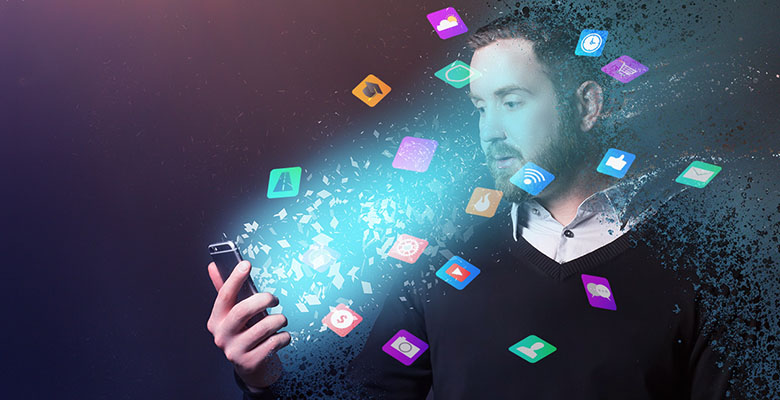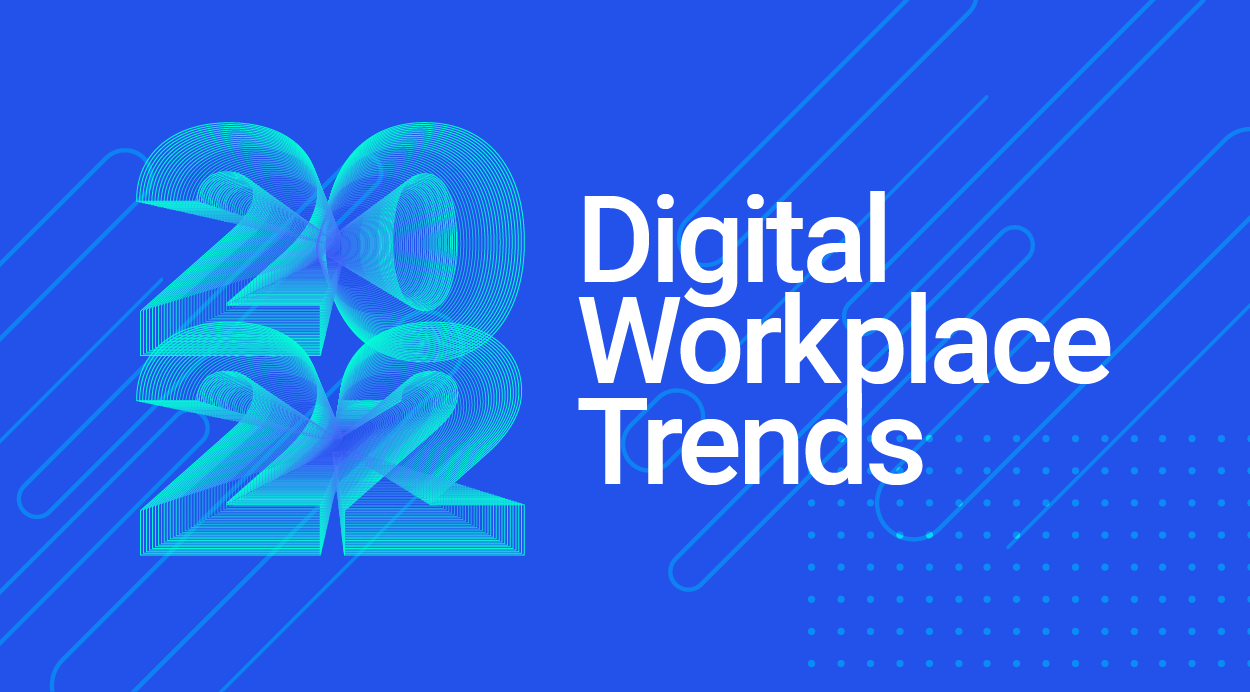Optimizing the digital workplace for employees
We all know that over the past two years, the pandemic has changed the nature of work.
Digital transformation efforts accelerated dramatically – by an average of 5.3 years - to enable widespread remote work
Organizations found that remote work was often more efficient than office-based work, with 77% reporting increased productivity
Hybrid work models are now taking center stage, with 83% or workers preferring a hybrid work model, as organizations find the right balance of remote and in-person work
But the pandemic has also changed the nature of employees.
New research finds that 88% of workers are taking control of their well-being. They’re bucking long-standing paradigms to redefine success, prioritizing work-life balance, mental health, and having a meaningful job over a steady paycheck. This revolution in perspective couldn’t have come at a better time. Stress and burnout are real, with disastrous long-term effects.
Unfortunately, simply shining a spotlight on employee well-being hasn’t been enough to cure the problem. Workers are still suffering from burn out, with 81% feeling more burned out now than they were at the beginning.
So what can organizations do to help employees manage stress and work effectively as they transition into the likely long-term model of hybrid work?
They can start by assessing their digital employee experience programs. Remember, for many employees, the digital workplace is the only workplace they have. If that experience is confusing, frustrating, and more difficult than it needs to be, employees (and therefore the business) will suffer.
There are three actions you can start taking today to improve the digital employee experience at your organization.
#1 Focus - Help employees better manage their attention so they can spend more time on work that matters.
#2 Simplify - Eliminate needless digital friction that wastes time and causes frustration.
#3 Enable - Empower business partners to accelerate digital transformation.
Let's look at each of these actions in more detail to understand the strategies and technologies you'll need to achieve success.
Focus
Guiding attention in the digital workplace
There’s no doubt that employees struggle with focus and where to direct their attention at work. And that’s due in large part to the rise of new apps and collaboration platforms being deployed to help employees stay connected and be productive. But while all these tools are great individually, together they create an unmanageable stream of notifications, updates, emails, and messages.

The average company maintains 651 SaaS applications - and, on average, adds ten new applications to the stack every month. (Source)
It also doesn’t help that many of these applications use strategies that enable them to gain multiple inroads to organizations in an effort to be the app with the greatest influence. Technology ends up fighting technology and the ultimate loser is the employee who is simply overwhelmed with all the places they have to go to find information and complete tasks (Gartner® refers to this phenomenon as “YATTC,” or Yet Another Thing to Check).
Unfortunately, none of this is new. Employees have always struggled with how to spend their time effectively, it’s just the source of their struggle that has changed over time. There are ways to help alleviate the problem though, both through strategy and technology.
Strategy: Support an enterprise attention management initiative
Prior to the pandemic, organizations implemented changes with the longstanding expectation that employees would just adapt and overcome. In a post-pandemic world, however, employees are exerting much more power and autonomy to work however, wherever, and whenever it’s convenient for them – and they expect the companies they work for to deliver technology that supports those needs for flexibility and mobility.
Organizations should embrace this shift. Implementing an enterprise attention management mentality is as an opportunity to deliver solutions that unlock the power of their workforce. It will enable better business results, have a tremendous impact on employee engagement and satisfaction, plus make it easier to attract and retain top talent.
Technology: Create an integrated digital work experience that guides employees' attention in the flow of work
Digitization is only going to continue to drive an increasing amount of data and information. So how can organizations use technology to help employees combat the noise?
It starts by understanding that technology needs and expectations vary widely across the employee base. Take the simple use of a mobile phone, for example. Some workers never use the phone functionality, preferring to communicate via text or email. Other employees, however, find texting to be time-consuming (or maybe they struggle to read on such a small screen) and prefer voice communication. Recognizing that these differences exist is the first step in delivering technology that supports the entire workforce.
The next step is to implement technology that helps employees filter and prioritize the vast amounts of information that come at them every day. Organizations should focus on using systems that bring tasks and information to employees, so that they don’t have to waste time hunting for them (Gartner® refers to this as a “Guided Attention Strategy”).

A modern digital workplace enables effective attention management by putting important tasks and information at employees' fingertips, no matter how, or where, they chose to work.
By enabling employees to have access to routine tasks and information wherever they are, whenever they need them – right within the flow of their work, whether via mobile, workstream collaboration apps like Teams or even on the intranet – employees know what needs their attention and can work more efficiently.
Simplify
Eliminating needless digital friction
It’s a widely shared sentiment that the technology that’s supposed to make work easier is actually complicating things, increasing the number of steps it takes to complete tasks and making it more difficult to get our jobs done. This is the very essence of what digital friction is all about.

Gartner describes digital friction as “The unnecessary effort an employee has to exert to use data or technology for work. This gets in the way of focusing on the right tasks and making the right decisions.”
So where does digital friction come from? It falls into three main categories…
Application Overload - The ever-expanding range of applications and sources where information and activity are hosted.
Information Overload - The volume of content, conversations, activity, interactions, tasks, and information employees are expected to continually process.
Digital Noise Pollution - The exponential echo effect of signals, pings, and chimes vying for employees' attention.

Digital friction and overload costs the U.S. economy a minimum of $900 billion per year in lowered employee productivity and reduced innovation. (Source)
You’d think that with the incredible technological advancements that have been made over the last decade that this problem would have gotten better, but in reality, it’s only gotten worse. That’s namely because software continues to be designed with the vendor-to-enterprise sale in mind, with no consideration for the individual user journey or experience, as is typically seen in the customer experience marketplace.
That doesn’t mean that digital friction can’t be reduced dramatically when approached with the right strategy and technology.
Strategy: Enterprise accountability for improving the quality of digital experiences
Once organizations have accepted the fact that digital friction is a problem, they should look broadly across the employee experience and journey of all personas to understand the reality of the work experience. Once there’s an understanding of the culture, personas, and processes, as well as the technology landscape, there are four simple strategies that can help minimize digital friction and improve the overall digital experience.

Start with quick wins - Address employees' top pain points as an easy entryway to digital transformation efforts.
Modernize legacy systems - Asses how existing technology could be perpetuating ongoing problems and ask foundational questions, such as:
When was the last time the digital landscape was rationalized?
What's being used?
What's not being managed?
When should certain technologies be used and for what activities?
How much tech debt has accrued over the recent years?
Utilize outcome-driven design - Design processes that help employees fulfill their intent and achieve their desired outcome as effectively as possible and ask the question "how?" How do you wish to communicate, collaborate, connect, and operate?
Facilitate multichannel delivery - Deliver the experience wherever an employee needs access, whether that's via mobile, in a workstream collaboration app like MS Teams, or even on the intranet.
Technology: Create experiences that streamline and automate processes
Many enterprise apps today offer some ability to reduce digital noise pollution by adjusting the frequency of messages and app notifications, pop-ups, etc. That certainly helps (every little bit does), but it’s little more than a band-aid approach to a much bigger problem.
What’s really needed to reduce digital friction is an employee-first approach to the overall digital experience, one that weaves employee need into the technical landscape and prioritizes the right information, notifications, and actions, at the right time – in an intelligent manner – regardless of where the employee is working.
Let’s take look at an example that most can relate to, ordering office equipment to work from home…
Most people never expected the sudden shift to remote work to be permanent. There was an assumption that the disruption would last a few weeks at most, and we adapted quickly and easily to that new reality, setting up working spaces wherever there was a big enough surface to set a laptop. But as the weeks turned into months and then a year, backs grew sore, wrists began cramping, and we all needed to face the fact that were weren’t going back to our offices any time soon. We needed more formal office equipment. But there was a big roadblock - how did we go about getting it?
The journey most employees went on to order the equipment they needed was frustratingly similar.
It started with reaching out to bosses and colleagues to see if they knew how. If that didn’t prove useful, people moved on to a search of the intranet – also a frustrating dead end that turned up plenty of articles about offices closures, policies about getting into the office, even the café menu from March 2020 was found, but no instructions about ordering office equipment. The HR portal was likely the next stop. This uncovered interesting stuff about setting up space for new hires along with articles about the importance of working ergonomically and details about virtual yoga classes being offered. But still nothing about ordering equipment.
You get the point. Thousands of hours were wasted in organizations around the globe as employees tried to find the very basic information on how to order office equipment. Hardly a great employee experience, and certainly no good for business. But what’s the alternative?

That entire scenario could have been eliminated by using technology to help employees quickly and easily fulfill their intent and find the information they’re looking for.
There are many ways this could be accomplished, but one example would be a chatbot that enabled employees to easily ask the question, “How do I order office equipment?” Simply getting employees to this answer quickly would be a big step towards reducing digital friction. But now take it a step further. If you actually connected employees to the procurement system as part of the response returned by the chatbot, you’d not only reduce friction even further, but you’d also be on the path to creating the modern digital experience employees expect and deserve.
Enable
Empower business partners to accelerate digital transformation
Businesses are in a perpetual battle to keep up with changes in technology, and unfortunately find themselves in a reactionary mode when big issues such as the pandemic force massive change very quickly. It’s a stress that affects the entire organization, particularly when viewed in light of other factors…
By 2026, business will be competing for engineering talent to fill an estimated 1.2 million job openings
40% tech budgets are shifting over to the business
IT projects are increasing by 30% just to keep the lights on
Add to this the traditional IT problems, like tech debt and aging systems, and it’s no wonder nearly half of businesses are worried about employee burnout.

There are ways to ease these stressors, thankfully.
Strategy: Embrace a democratization approach to innovation & technology
It’s an inconvenient fact that innovation isn’t as simple as buying new technology or enlisting the best-and-brightest minds in the organization to come up with clever ideas.
Instead, embracing innovation requires a strategy, which of course also means managing organizational change within the company. That was the case with the shift to Agile years ago. Tight bonds between business and IT needed to be formed and a focus on small, quick deliveries and iterative change needed to be fostered to drive innovation, all of which required a different mindset and organizational transformation for many companies.
Organizations can mitigate the disruption of technological change by putting the power of technology and innovation capabilities into the hands of business users.

It’s a mindset shift that many companies may find challenging, but it only makes sense. The past 10-15 years have been all about democratizing access to information and content creation - why not problem solving and innovation? By decentralizing access to some tools traditionally reserved for IT, more employees can be empowered to innovate and iterate on their own to accelerate an organization’s digital transformation efforts. This will be critical given the fact that innovation will be a driving factor of business success in the coming years. Organizations will have to use every available advantage, including democratized innovation, if they want to remain competitive.
Technology: Leverage no-code development to enable business teams to optimize the employee experience
Thanks to the rapid rise of no-code development, predictions estimate that in just the next few years, the vast majority of tech products delivered by organizations will have been built by citizen developers rather than IT. In that same time span, 75% of businesses will explore at least 4 no code tools.
Taking advantage of this rise in no-code development will be key to driving innovation for organizations, paving the way for business partners who have access to system credentials to drag and drop their way to custom workflows, automations, and other valuable business outcomes.
No code development offers many benefits, not the least of which are speed and flexibility, making it possible to deliver custom applications within days or weeks rather than months – all without the assistance of IT. It also makes use of existing tech investments, so organizations can increase usage and adoption of valuable business solutions while also delivering the custom experiences their employees need.

The market is seeing a steady increase in software companies adding no-code functionality to their platforms. Organizations considering this path should evaluate potential solutions against these criteria:
Easy-to-use interface with drag and drop functionality that enables users to edit, preview, and test as they go
Simple validation and deployment methods
Speed in delivering high-value outcomes





